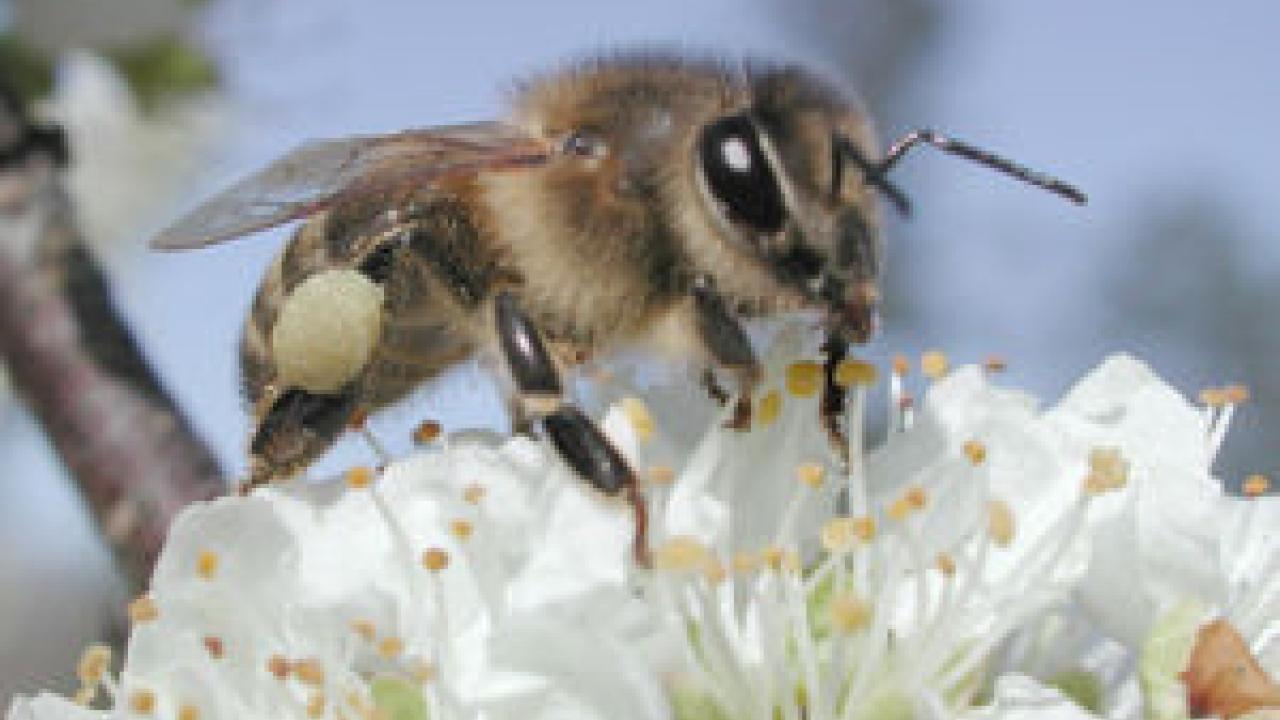Wild bees push domestic cousins
Domesticated honeybees, pollinators of up to a third of the nation's food supply, are up to five times more efficient when wild bees buzz the same fields where the domesticated bees are working, according to a study published in the journal Proceedings of the National Academy of Sciences of the USA. "As honeybees become more scarce, it becomes more important to have better pollinators," said Sarah Greenleaf, a postdoctoral researcher at UC Davis and first author on the study. As a graduate student at Princeton University, Greenleaf carried out a two-year study of honeybees used to pollinate sunflower crops on farms near UC Davis. Compared to honeybees, wild bees did not contribute much directly to crop pollination. But on farms where wild bees were abundant, honeybees were much more effective in pollinating flowers and generating seeds, Greenleaf found. There appeared to be two reasons: Male wild bees, probably looking for mates, latch onto worker honeybees, which are sterile females, causing them to move from one flower to another. Secondly, female wild bees appeared to "dive bomb" honeybees, forcing them to move. Frequent movement between flowers spreads pollen more effectively. Greenleaf and her co-author Claire Kremen, now a professor at UC Berkeley, calculated that wild bees contributed about $10 million of value to the $26 million sunflower industry alone.
-- Andy Fell
Scholar watches DNA repair self
Direct observation of DNA is giving new insights into how genetic material is copied and repaired. "We can monitor the process directly, and that gives us a different perspective," said Roberto Galletto, a postdoctoral scholar at UC Davis and first author on a paper published Sept. 20 on the Web site of the journal Nature. In E. coli bacteria, molecules of an enzyme called RecA attach themselves along a DNA strand, stretching it out and forming a filament. A piece of complementary DNA lines up alongside it, and pieces of DNA can be swapped in to repair gaps in the original strand. A similar protein, Rad51, does the same job in people. "How RecA and Rad51 assemble into filaments determines the outcome of DNA repair, but very little is known about how assembly is controlled," said senior author Stephen Kowalczykowski, professor in the sections of Microbiology and of Molecular and Cellular Biology, and director of the Center for Genetics and Development at UC Davis. Genes that control Rad51 have been linked to increased risk of breast cancer.
-- Andy Fell
2 genetic profiles ID'd for modern Europeans
UC Davis Health System scientists led international genetics research that placed modern Europeans into two groups — Northern and Southern, or Mediterranean — in a finding labeled important because the groupings provide a way for researchers to account for European ancestry when looking for genes involved in diseases. The findings appeared in the Public Library of Science Genetics. "Until now, little has been known about the distribution of genetic variation in European populations and how much that distribution matters in terms of doing genetic studies," said Michael Seldin, chair of the Rowe Program in Genetics at the health system. "Now we will be able to control for these differences in European populations." Seldin, a professor of biochemistry and medicine at UC Davis, worked with his colleagues to compare genetic data for 928 people. The researchers looked at 5,700 nucleotide polymorphisms, called SNPs or "snips." SNPs are changes in which a single base in DNA differs from the usual base at that position. Millions of SNPs have been cataloged in the human genome. Some SNPs cause diseases, like sickle cell anemia. Other SNPs are normal variations in the genome. People who share ancestry will have many SNPs in common.
-- Carole Gan, UC Davis Health System
Media Resources
Dave Jones, Dateline, 530-752-6556, dljones@ucdavis.edu
